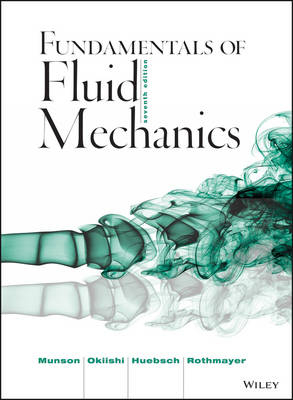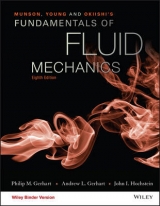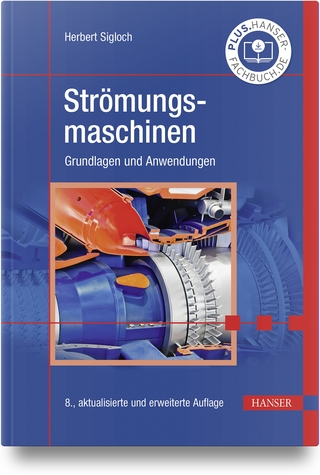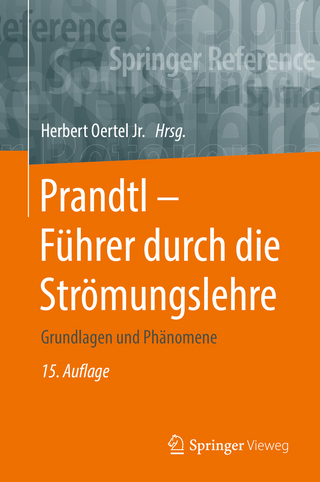
Fundamentals of Fluid Mechanics
John Wiley & Sons Inc (Verlag)
978-1-118-11613-5 (ISBN)
- Titel erscheint in neuer Auflage
- Artikel merken
Fundamentals of Fluid Mechanics, 7th Edition offers comprehensive topical coverage, with varied examples and problems, application of visual component of fluid mechanics, and strong focus on effective learning. The text enables the gradual development of confidence in problem solving. The authors’ have designed their presentation to enable the gradual development of reader confidence in problem solving. Each important concept is introduced in easy-to-understand terms before more complicated examples are discussed. Continuing this book's tradition of extensive real-world applications, the 7th edition includes more Fluid in the News case study boxes in each chapter, new problem types, an increased number of real-world photos, and additional videos to augment the text material and help generate student interest in the topic. Example problems have been updated and numerous new photographs, figures, and graphs have been included. In addition, there are more videos designed to aid and enhance comprehension, support visualization skill building and engage students more deeply with the material and concepts.
1 Introduction 1
Learning Objectives 1
1.1 Some Characteristics of Fluids 3
1.2 Dimensions, Dimensional Homogeneity, and Units 4
1.3 Analysis of Fluid Behavior 11
1.4 Measures of Fluid Mass and Weight 11
1.5 Ideal Gas Law 12
1.6 Viscosity 14
1.7 Compressibility of Fluids 20
1.8 Vapor Pressure 23
1.9 Surface Tension 24
1.10 A Brief Look Back in History 27
1.11 Chapter Summary and Study Guide 29
2 Fluid Statics 40
Learning Objectives 40
2.1 Pressure at a Point 40
2.2 Basic Equation for Pressure Field 42
2.3 Pressure Variation in a Fluid at Rest 43
2.4 Standard Atmosphere 49
2.5 Measurement of Pressure 50
2.6 Manometry 52
2.7 Mechanical and Electronic Pressure-Measuring Devices 57
2.8 Hydrostatic Force on a Plane Surface 59
2.9 Pressure Prism 65
2.10 Hydrostatic Force on a Curved Surface 68
2.11 Buoyancy, Flotation, and Stability 70
2.12 Pressure Variation in a Fluid with Rigid-Body Motion 74
2.13 Chapter Summary and Study Guide 79
3 Elementary Fluid Dynamics—The Bernoulli Equation 101
Learning Objectives 101
3.1 Newton’s Second Law 101
3.2 F ma along a Streamline 104
3.3 F ma Normal to a Streamline 108
3.4 Physical Interpretation 110
3.5 Static, Stagnation, Dynamic, and Total Pressure 113
3.6 Examples of Use of the Bernoulli Equation 117
3.7 The Energy Line and the Hydraulic Grade Line 131
3.8 Restrictions on Use of the Bernoulli Equation 134
3.9 Chapter Summary and Study Guide 139
4 Fluid Kinematics 157
Learning Objectives 157
4.1 The Velocity Field 157
4.2 The Acceleration Field 166
4.3 Control Volume and System Representations 175
4.4 The Reynolds Transport Theorem 176
4.5 Chapter Summary and Study Guide 188
5 Finite Control Volume Analysis 199
Learning Objectives 199
5.1 Conservation of Mass—The Continuity Equation 200
5.2 Newton’s Second Law—The Linear Momentum and Moment-of-Momentum Equations 213
5.3 First Law of Thermodynamics—The Energy Equation 236
5.4 Second Law of Thermodynamics—Irreversible Flow 253
5.5 Chapter Summary and Study Guide 253
6 Differential Analysis of Fluid Flow 276
Learning Objectives 276
6.1 Fluid Element Kinematics 277
6.2 Conservation of Mass 282
6.3 Conservation of Linear Momentum 288
6.4 Inviscid Flow 292
6.5 Some Basic, Plane Potential Flows 286
6.6 Superposition of Basic, Plane Potential Flows 308
6.7 Other Aspects of Potential Flow Analysis 318
6.8 Viscous Flow 319
6.9 Some Simple Solutions for Viscous, Incompressible Fluids 321
6.10 Other Aspects of Differential Analysis 331
6.11 Chapter Summary and Study Guide 332
7 Dimensional Analysis, Similitude, and Modeling 346
Learning Objectives 346
7.1 Dimensional Analysis 347
7.2 Buckingham Pi Theorem 349
7.3 Determination of Pi Terms 350
7.4 Some Additional Comments about Dimensional Analysis 355
7.5 Determination of Pi Terms by Inspection 359
7.6 Common Dimensionless Groups in Fluid Mechanics 360
7.7 Correlation of Experimental Data 364
7.8 Modeling and Similitude 368
7.9 Some Typical Model Studies 374
7.10 Similitude Based on Governing Differential Equations 384
7.11 Chapter Summary and Study Guide 387
8 Viscous Flow in Pipes 400
Learning Objectives 400
8.1 General Characteristics of Pipe Flow 401
8.2 Fully Developed Laminar Flow 407
8.3 Fully Developed Turbulent Flow 416
8.4 Dimensional Analysis of Pipe Flow 426
8.5 Pipe Flow Examples 445
8.6 Pipe Flowrate Measurement 459
8.7 Chapter Summary and Study Guide 465
9 Flow Over Immersed Bodies 480
Learning Objectives 480
9.1 General External Flow Characteristics 481
9.2 Boundary Layer Characteristics 489
9.3 Drag 512
9.4 Lift 528
9.5 Chapter Summary and Study Guide 541
10 Open-Channel Flow 554
Learning Objectives 554
10.1 General Characteristics of Open-Channel Flow 555
10.2 Surface Waves 556
10.3 Energy Considerations 561
10.4 Uniform Depth Channel Flow 566
10.5 Gradually Varied Flow 575
10.6 Rapidly Varied Flow 576
10.7 Chapter Summary and Study Guide 589
11 Compressible Flow 601
Learning Objectives 601
11.1 Ideal Gas Relationships 602
11.2 Mach Number and Speed of Sound 607
11.3 Categories of Compressible Flow 610
11.4 Isentropic Flow of an Ideal Gas 614
11.5 Nonisentropic Flow of an Ideal Gas 631
11.6 Analogy between Compressible and Open-Channel Flows 655
11.7 Two-Dimensional Compressible Flow 657
11.8 Chapter Summary and Study Guide 658
12 Turbomachines 667
Learning Objectives 667
12.1 Introduction 668
12.2 Basic Energy Considerations 669
12.3 Basic Angular Momentum Considerations 673
12.4 The Centrifugal Pump 675
12.5 Dimensionless Parameters and Similarity Laws 688
12.6 Axial-Flow and Mixed-Flow Pumps 693
12.7 Fans 695
12.8 Turbines 695
12.9 Compressible Flow Turbomachines 707
12.10 Chapter Summary and Study Guide 713
References 715
Review Problems 715
Conceptual Questions 715
Problems 716
A Computational Fluid Dynamics 725
B Physical Properties of Fluids 737
C Properties of the U.S. Standard Atmosphere 742
D Compressible Flow Graphs for an Ideal Gas (k 1.4) 744
E Comprehensive Table of Conversion Factors See www.wiley.com/college/munson or WileyPLUS for this material.
F CFD Problems and Tutorials See www.wiley.com/college/munson or WileyPLUS for this material.
G Review Problems See www.wiley.com/college/munson or WileyPLUS for this material.
H Lab Problems See www.wiley.com/college/munson or WileyPLUS for this material.
I CFD Driven Cavity Example See www.wiley.com/college/munson or WileyPLUS for this material.
Answers ANS-1
Index I-1
Video Index VI-1
| Erscheint lt. Verlag | 18.4.2017 |
|---|---|
| Verlagsort | New York |
| Sprache | englisch |
| Maße | 224 x 277 mm |
| Gewicht | 1740 g |
| Themenwelt | Naturwissenschaften ► Physik / Astronomie ► Strömungsmechanik |
| Technik ► Bauwesen | |
| Technik ► Maschinenbau | |
| ISBN-10 | 1-118-11613-5 / 1118116135 |
| ISBN-13 | 978-1-118-11613-5 / 9781118116135 |
| Zustand | Neuware |
| Haben Sie eine Frage zum Produkt? |
aus dem Bereich



